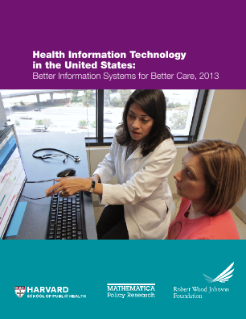 Federal financial support for HIT drives system change; proportion of hospitals with EHRs triples since 2010.
Federal financial support for HIT drives system change; proportion of hospitals with EHRs triples since 2010.
Driven by major federal investments in health information technology (HIT) over the last several years, hospitals, physicians and other providers have made significant strides in the adoption of health information technology, according to the Robert Wood Johnson Foundation’s annual report, Health Information Technology in the United States: Better Information Systems for Better Care, 2013.
The report, co-authored by Mathematica Policy Research and the Harvard School of Public Health, finds that in 2012, 44 percent of hospitals reported having a basic electronic health record system—commonly called an EHR—up 17 percentage points from 2011. Since 2010, when health care providers began receiving federal funding to encourage EHR adoption, the proportion of hospitals with at least a basic EHR has nearly tripled. Physicians have also made substantial progress, with 38.2 percent reporting the adoption of basic EHR functionalities in 2012.
These improvements in adoption are coupled with significant spikes in the use of HIT tools by providers—42 percent of hospitals reported the implementation of all functionalities required to meet the standards of stage one of the federal “Meaningful Use” program, up from 18.4 percent in 2011 and 4.4 percent in 2010.
Still, researchers noted several areas where providers can improve their adoption and usage of HIT. While U.S. physicians reported increased use of EHRs in 2012, the United States lags behind several other developed countries. In addition, researchers found room for improvement in using HIT to develop effective patient education tools that track progress and meaningfully engage patients.
“Hospitals, physicians and other health care providers are clearly taking advantage of recent incentives to embrace the promise of technology,” said John R. Lumpkin, MD, MPH, senior vice president at the Robert Wood Johnson Foundation. “It’s particularly encouraging to see that more doctors and hospitals are using electronic health records, which contribute to better care at the bedside. But there is still a significant amount of work to be done to ensure that our health care system is as up-to-date as it can be. These kinds of technologies can lead to safer, higher-quality care.”
Increasingly, health care providers are connecting their EHR initiatives with broader HIT partnerships in their communities. Twenty-seven percent of hospitals are now participating in health information exchange (HIE) initiatives, up from 14 percent in 2010. HIEs enable different care providers to securely share patient information with each other. Ten percent of ambulatory practices were engaged in one of the nation’s 119 HIEs, up from 3 percent in 2010. In addition, 32 percent of the HIEs reported supporting Accountable Care Organizations, while 45 percent are supporting Patient-Centered Medical Homes.
Rural hospitals are also closing the EHR adoption gap with their urban counterparts. The proportion of rural hospitals with at least a basic EHR increased from 9.8 percent to 33.5 percent from 2010-12. During the same time frame, urban hospitals saw their EHR adoption rates rise from 17 percent to 47.7 percent.
This report was produced by a team of researchers at the Robert Wood Johnson Foundation, Mathematica Policy Research and the Harvard School of Public Health, using data from sources including: the Agency for Healthcare Research and Quality; the American Hospital Association Health Information Technology Supplement; the European Commission; Indian Health Services; the National Ambulatory Medical Care Survey: Electronic Medical Records Supplement, conducted by the National Center for Health Statistics; the Office of the National Coordinator for Health Information Technology; the Organisation for Economic and Cooperative Development; the Robert Wood Johnson Foundation/Commonwealth Fund National Survey of Physicians; the State HIE Cooperative Agreement Program; and the World Health Organization. The report was released during a Health Affairs briefing at the National Press Club in Washington, D.C.
ABOUT THE ROBERT WOOD JOHNSON FOUNDATION
The Robert Wood Johnson Foundation focuses on the pressing health and health care issues facing our country. As the nation’s largest philanthropy devoted exclusively to health and health care, the Foundation works with a diverse group of organizations and individuals to identify solutions and achieve comprehensive, measurable, and timely change. For more than 40 years the Foundation has brought experience, commitment, and a rigorous, balanced approach to the problems that affect the health and health care of those it serves. When it comes to helping Americans lead healthier lives and get the care they need, the Foundation expects to make a difference in your lifetime. For more information, visit www.rwjf.org.
